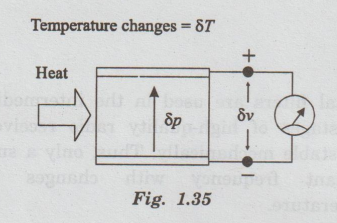Physics for Electrical Engineering: Unit I: Dielectric Materials and Insulation
Pyroelectricity
Definition, Formula
Pyroelectric effect is the change in spontaneous polarization when the temperature of the specimen is changed. The pyroelectric coefficient λ is defined as the change in polarization specimen.
PYROELECTRICITY
Pyroelectric
effect is the change in spontaneous polarization when the temperature of the
specimen is changed. The pyroelectric coefficient λ is defined as the change in polarization
specimen.
λ
= dP / dT
The
change in polarization results in change in external field and hence charge on
the surface. As it is possible to detect a charge of 10-16 C with a
suitable electrometer, temperature changes as small as 10-6°C can be
measured using the pyroelectric effect.
The
barium titanate crystal in figure 1.35 is also said to be pyroelectric because
when the temperature increases, the crystal expands and the relative distances
of ions change. The Ti4+ ion becomes shifted, which results in a
change in the polarization.
Temperature
changes = δ T

The
heat absorbed by the crystal increases the temperature by δ T, which induces a
change δ P in the polarization. This is
the pyroelectric effect. The change δ P gives rise to a change δ V the voltage
that can be measured.
(Examples:
Barium Titanate, Lithium Niobate, Lithium Tantalate and Polyvinyl fluoride).
Physics for Electrical Engineering: Unit I: Dielectric Materials and Insulation : Tag: : Definition, Formula - Pyroelectricity
Related Topics
Related Subjects
Physics for Electrical Engineering
PH3202 2nd Semester 2021 Regulation | 2nd Semester EEE Dept 2021 Regulation
